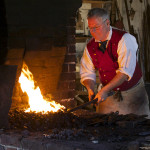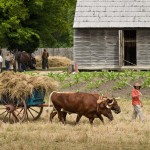 Plants in profusion and variety, both native and imported, grow in and around the Historic Area of Williamsburg. To provide the majority of the color in our gardens throughout the seasons, Colonial Williamsburg’s landscape staff and volunteers plant a combination of annuals, biennials and perennials.
Plants in profusion and variety, both native and imported, grow in and around the Historic Area of Williamsburg. To provide the majority of the color in our gardens throughout the seasons, Colonial Williamsburg’s landscape staff and volunteers plant a combination of annuals, biennials and perennials.
In June, we will have just completed planting heat-loving annuals in the flower beds. These annuals will stay in the beds until the fall when they are replaced with bulbs and cold-hardy annuals.
Two summer annuals that you will see throughout the Historic Area are the marigold and globe amaranth. Like many of the plants grown in the Historic Area, they were introduced to the New World before 1800.
Pot marigold
The 17th-century nurseryman, Thomas Fairchild, recommended both French (Tagetes patula) and African (T. erecta) marigolds for ornamental London gardens. Native to Mexico, both species are tough annuals that produce an abundance of flowers from midsummer to fall in a variety of colors and forms. Some marigolds of note include the double African marigold and the “striped French Marygold” that was bought by Sir Peyton Skipwith in 1793.
Native to Central America, the globe amaranth (Gomphrena globosa) tolerates heat, humidity and drought. The purple, pink or white clover-like flowers bloom from summer until frost. They are some of the best flowers you can grow for dried arrangements, so we use it in many of Colonial Williamsburg’s Christmas decorations. We know from historic documents that colonists also used globe amaranth in dried arrangements.
In 1742, English botanist Peter Collinson wrote to Williamsburg garden enthusiast John Custis that the globe amaranth “. . . is a Real and I may say perpetual Beauty. If the flowers are gather’d in perfection and hung up with their Heads Downwards in a Dry shady Room, they will keep thear Colours for years and will make a pleasant Ornament to Adorn the Windows of your parlor or study all the Winter. I Dry great quantities for that purpose and putt them in flower potts and China basons and they make a fine show all the Winter.”




Leave a Reply